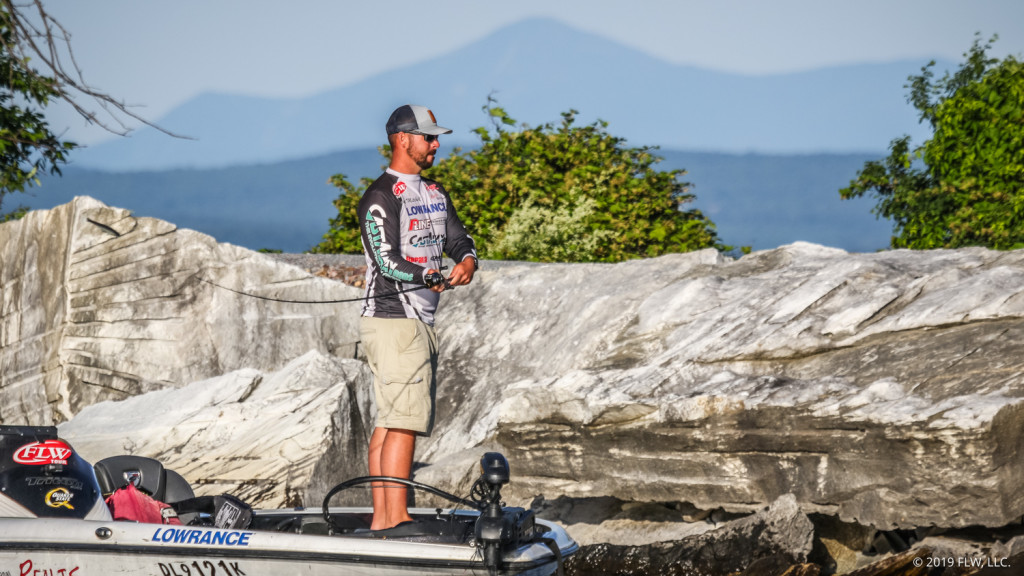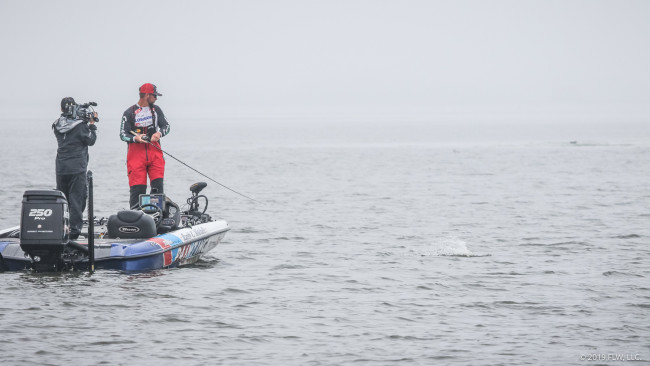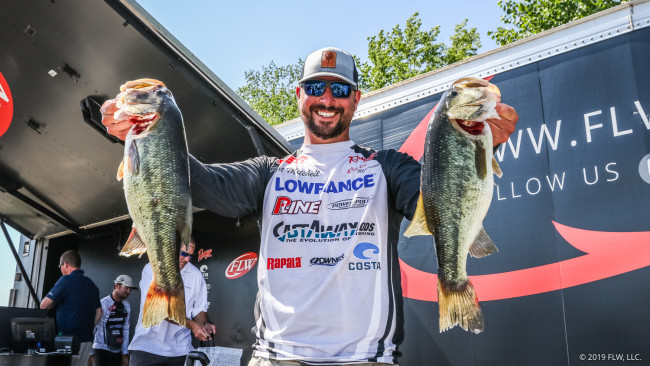Throw Bigger Swimbaits in Tournaments
How Kurt Mitchell has won money on big paddle-tail swimbaits in pro-level events

Fitting larger swimbaits into a tournament arsenal is a goal that a lot of anglers never hit. Tackle Warehouse Pro Circuit pro Kurt Mitchell has gotten it done, and actually earned a lot of money with some of the more specialized and larger swimbaits over the past few years.
“Last year, there was a place on Champlain. I went around it flipping a jig, and I caught like 10 off it, but they were all small. I picked up a swimbait, and I caught my biggest fish of the tournament off it on my very next cast,” says the Delaware pro. “I had just made 20 casts with the jig, and I made one cast with the swimbait.
“That’s what really got me with a swimbait. You get bites that you would not get throwing anything else. You can go to an area that’s pounded with pressure from people throwing drop-shots or jigs or whatever and get one bite that nobody else would get.”

The Setup
Mitchell has gravitated toward a handful of swimbaits for most of his tournament time. The first two are already well known by anyone who has watched Matt Arey on Beaver Lake: the 3:16 Lure Company Minnow and the LunkerHunt Fetch. His other baits are also not super rare or unusual, as he uses the 6-inch Optimum Boom Boom Rigged Swimbait and the 6-inch Megabass Magdraft.
Mitchell’s first foray into the larger swimbait game was with the Fetch and 3:16 Minnow around shallow bushes on Kentucky Lake, and he simply took it from there.
“I went on the whole Magdraft kick like everybody else. It’s a great bait, but I kinda got away from it,” outlines Mitchell. “Spots love the Magdraft. If it’s a lake that has spots I will definitely throw it, but that Boom Boom swimbait; that’s probably my favorite one, as far as a soft-body swimbaits goes.”
Mitchell pretty much sticks with a 7-foot, 6-inch, heavy-power Impulse Energy Series casting rod, though he’ll drop down in length if he’s skipping the baits around docks. He always uses a 6:1 gear ratio reel so he doesn’t work the baits too fast, and he likes 15- or 20-pound-test fluorocarbon line.
On the Boom Boom swimbait, Mitchell adds another split ring between the hook and the harness to help keep fish from throwing it and changes his treble to a 1/0 Gamakatsu Aaron Martens TGW MH Finesse Treble. He fishes unrigged swimbaits with the 6/0 Owner Weighted Beast hook, but trims off a little of the weight so that it’s closer to 1/16 ounce than the 1/4-ounce that comes stock.

Commit for success
One of the biggest keys to swimbait success for Mitchell is recognizing that it takes commitment to the bait, and the knowledge that he doesn’t actually need all-day success to make it happen.
“It seems like if you find a swimbait bite at all in practice, if you’re gonna go with a swimbait, you have to go all-in,” says Mitchell. “You can’t just pick it up for a couple hours because you’ll get little flurries. It’s the strangest thing, when I was on Cherokee last year, I had the biggest bag of the tournament on day two [19 pounds, 7 ounces]. I caught two big ones first thing in the morning, and then I went the rest of the day, until the last 15 minutes, without hooking another fish on the swimbait. Then in the last few minutes I caught a 5-pounder and two more 3-pounders. Nothing changed. They just decided to pull up and ate the swimbait.”
There are some clues to recognize that can help reassure you to keep throwing the swimbait.
“When you fish it all day, you’ll have followers and spots eating it, and that will key you in that it’s going to happen,” Mitchell says. “When you see that kind of activity, you know it’s going to happen, and it keeps your confidence up. I’ve had to put it down. I’ve had good practices with it and thrown it for like three hours with nothing – no activity, no follows. Then you’ve got to put it down and switch to something else. But, if you’re having something going on, it can happen.
“What’s made me successful with it is believing there’s a swimbait bite,” he adds. “A lot of guys just throw it around the spawn, but that swimbait bite is there almost 12 months of the year. You’ve just got to find it. Having confidence to know that I can put my head down and look for it helps me find it. It’s kinda like fishing Ticonderoga [on Lake Champlain]. I can go there and fish grass all day that’s not good, but I know if I put my head down and keep on fishing I will find grass mats that have populations of fish in them.”

How to fish them
Mitchell fishes the weedless baits and the rigged baits somewhat differently. He mostly keeps his weedless models ready for shallower water and to show him fish around the spawn. Through the rest of the year, the rigged baits get the call most often.
Mitchell will typically throw the rigged baits in less than 12 feet of water, but he says the distance to the fish is more important than the depth. So, if they’re suspending 15 feet down in a deep marina, he’s happy to throw a swimbait 5 or 10 feet under the surface of the water.
Mitchell usually sticks with a slow retrieve. If a fish misses his bait or follows it, he’ll sometimes drop the bait down to let the fish eat it or cast a wacky rig back to the fish, but he’s had the best success simply throwing the swimbait at them again. Regardless, seeing fish and not catching them is part of the game.
Another part of the game is having fish strike the bait and not hook up.
“It’s extremely common,” says Mitchell. “I have tried putting stinger hooks on it – on the head and the tail – but it does not work. You might get lucky and catch one, but when they’re coming and knocking it you just aren’t going to get them. But, almost always, when they’re doing that, they will eat it at some point in the day. That’s the thing about the swimbait: You don’t need them to eat it all day. You just need them to eat it for about 30 minutes.”
There are also differences in how northern and southern fish tend to behave with the swimbait.
“One thing that’s really weird is down south you’ll get more followers than you get up north. You might only get four or five bites, but you might see 25 fish follow it. Whereas up north, you might catch 10, but only see two or three follow it,” says Mitchell. “The northern fish, you don’t have to do anything to trick them. They’re more aggressive for the most part, and they haven’t seen very many big swimbaits. But, down south, you gotta be ready for fish short-striking your swimbait and fine tune your color. Those southern fish, they’ve seen it, so you have to keep throwing new things at ’em.
“Sometimes you’ve gotta wait ’em out down south. At Chickamauga, I was getting crushed all morning long, and I couldn’t hook them. But I kept throwing and throwing, and about 12 o’clock I caught an 8-pounder and 4-pounder and it was game on.”

The rewards are there
There’s no question that swimbaiting can burn you spectacularly, but leaning on more “tournament sized” swimbaits like Mitchell is using can help improve your success. If you do get into it, know that it’s maybe even more addicting than a jig or a frog bite.
“I would go to these clear lakes down south, and a lot of these lakes are too clear to get a bite going with a crankbait. I wanted to power fish, but I couldn’t get that bite going like I could in Delaware,” says Mitchell. “So, I started throwing a swimbait. The first time I did it, I had some giant followers that I would never have seen before. It opened my mind and got me fixated on it, and now I’m addicted to it.”